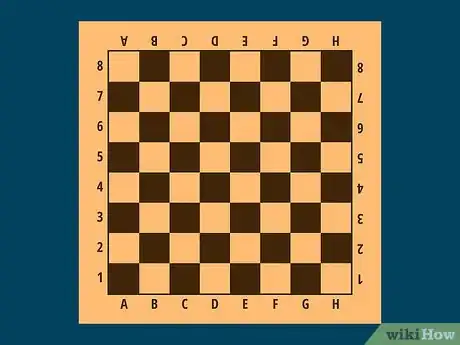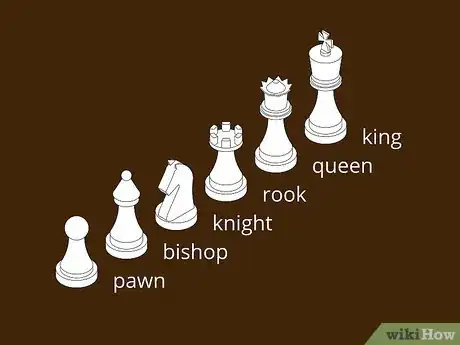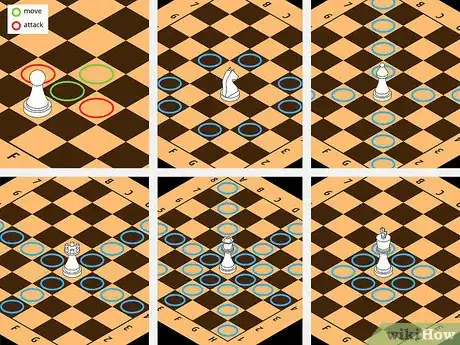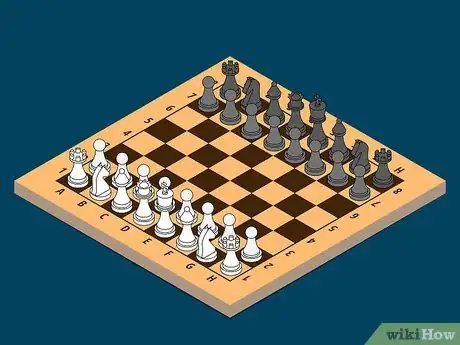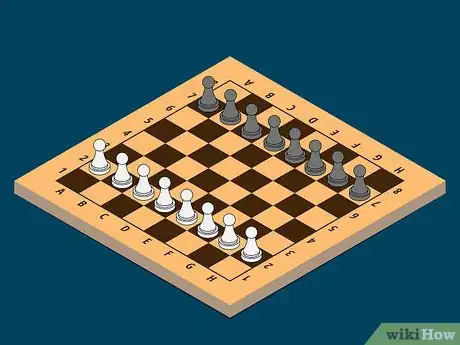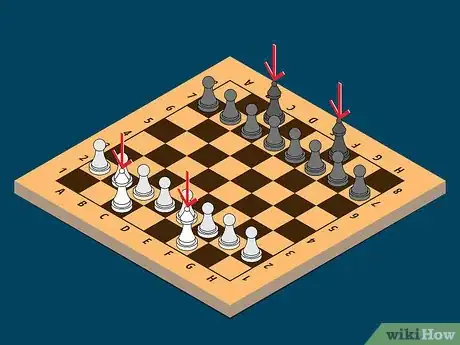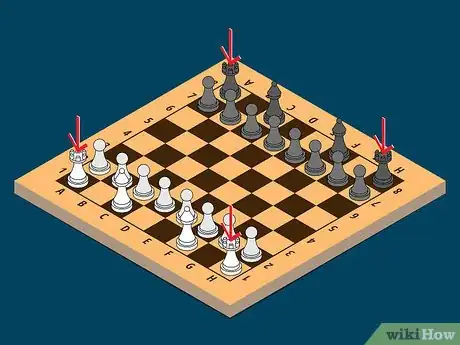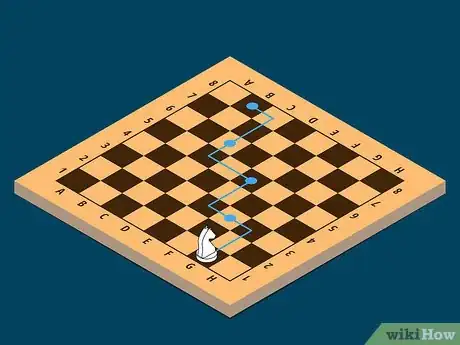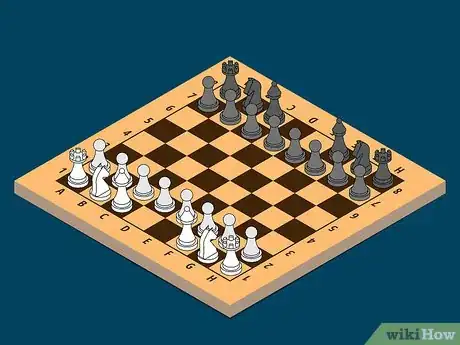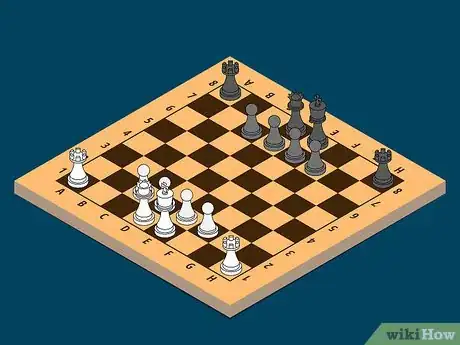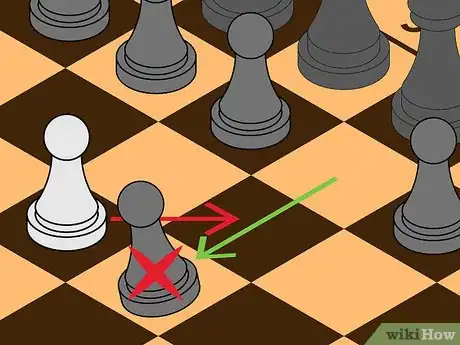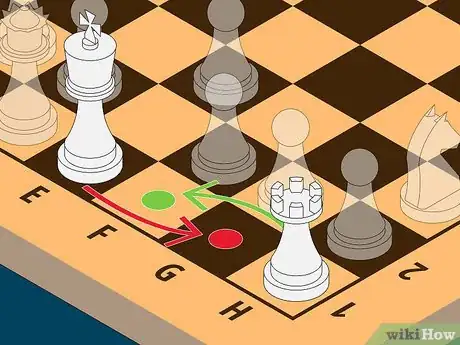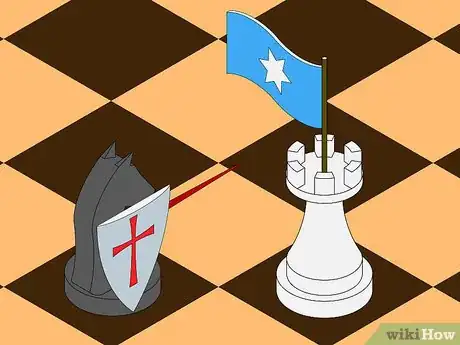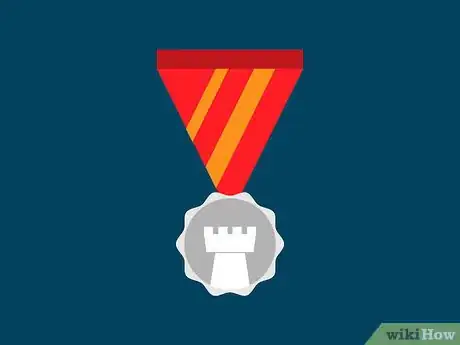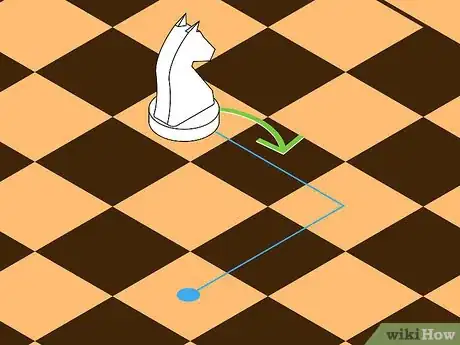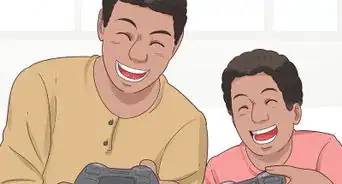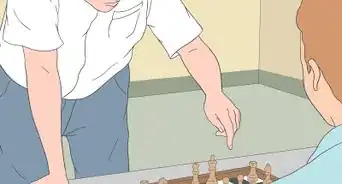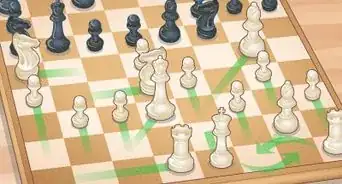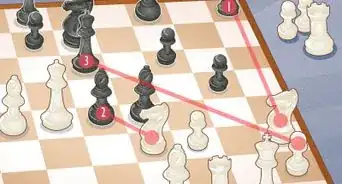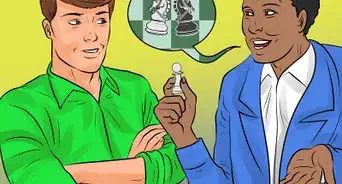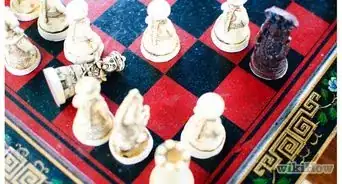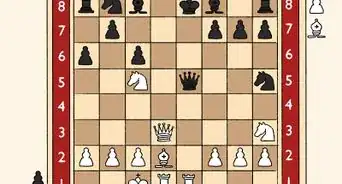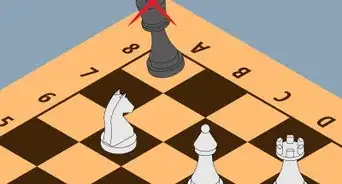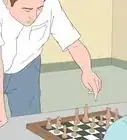This article was co-authored by Vitaly Neimer. Vitaly Neimer is an International Chess Master and Certified Professional Chess Coach with over 15 years of training experience. He has been a part of the United States' Webster SPICE national chess champion team and is also a two-time Israeli national chess champion.
There are 8 references cited in this article, which can be found at the bottom of the page.
wikiHow marks an article as reader-approved once it receives enough positive feedback. This article received 21 testimonials and 90% of readers who voted found it helpful, earning it our reader-approved status.
This article has been viewed 216,684 times.
Chess is a great game that can teach children how to think strategically and analyze situations. Start with the basic concepts such as the different pieces and the movements that each piece can make. Once your child has mastered that information, begin to play modified versions of a game of chess. Allow your child to learn at their own pace, and always be encouraging and patient. You want your child to develop a love for the game and think of chess as a fun activity.
Steps
Introducing the Board and Pieces
-
1Explain the chess board. A chess board has 8 rows (ranks) and 8 columns (files). There are 64 squares total. Half of the squares are a light color and half of the squares are a dark color. If you do not have a chess board, you can draw one on a dry erase board or chalk board.
- If you are teaching in a classroom, it may help to number the horizontal squares from 1 to 8, and letter the vertical squares from “a” to “h.” You can then use a coordinate system while you are teaching.
-
2Begin teaching the pieces. Explain the pawns, knights, rooks, bishops, king, and queen. Note the differences in how each piece looks. Place the pieces on the board so the child can see the proper position.[1]
- The knight usually looks like a horse.
- The bishop looks like a hat.
- The king is the most important piece because the object of the game is to checkmate the opponent’s king.
- Point out the difference in the shape of the queen and king pieces
- Rooks are also called castles.
Advertisement -
3Continue explaining the pieces. Go through each piece and explain how each piece moves on the board. Make sure the child understands a piece before you move on to the next.
- A pawn can move two spaces from its starting position, but only one space after that. A pawn can only capture a piece when it moves diagonally and can never move backwards.
- A knight is the only piece that can jump over another piece. It moves in an “L” shape. It can move 2 spaces horizontally and then one space vertically, or it can move 2 spaces vertically and then one space horizontally.
- The bishop can move diagonally and any number of squares.
- Rooks can move any number of squares forwards, backwards, or horizontally. The rook cannot move diagonally.
- The queen can move in any direction and any number of squares. It is one of the most powerful pieces.
- The king can move one space in any direction, but two kings can never be side by side.
-
4Place all the pieces on the board. Set up a chess board with all of the pieces. Your child should be able to identify each piece by name. Once they have the names down, begin to focus on the movement each piece makes. If you are using the coordinates method, this is how the chess board should be set up:
- Each player gets 8 pawns that lie on the 2nd and 7th rows
- Rooks/castles are in column A and H of rows 1 and 8.
- The queen is on column D of rows 8 and 1.
- The bishop is on column C and F of rows 8 and 1.
- The knights are on column B and G of rows 8 and 1.
- The king is in column E of rows 8 and 1.
Playing Games to Teach Movement
-
1Play a pawns-only game. Set up the chess board with only pawns. The goal of the game is to move as many of your pawns to the other side of the board. If two pawns meet and cannot move, they are stuck. Remind the child that the pawn can only move one space forward unless it is capturing the opponent’s pawn. If it is capturing, it can move one space diagonally.
- An alternate goal of the game can be to see who can move a single pawn to the other side first.
- Remind the child that the white pawn moves first and that pawns can take two spaces on a first move.
- This helps the child get used to playing with the pawns.
-
2Add the bishops. Once the child has a good grasp of pawn movement, add the bishops to the game. The goal of the game remains the same. Remind the child that the bishops can only move diagonally. This game teaches the child to:[2]
- Use their pawns to protect their bishop.
- Decide the best time to let their bishop out in front of their pawns.
- Get their bishop behind their opponent’s pawns.
- Understand the limitations that come with only being allowed to move the bishop diagonally.
-
3Introduce the rooks. Place the rooks, bishops, and pawns on the board. The objective is still to get a pawn all the way to the other side of the board. Remind the child that the rook can move any number of squares vertically or horizontally, but it cannot jump another piece.[3]
- The child should learn the importance of keeping the rook until the end of the game.
- At this stage, the child should also begin to see the difference between taking their opponent’s piece and winning the actual game.
-
4Place the knights on the board. Allow the child to move the knights on an empty board. The “L” movement is very unique and may take a little time. Pick a spot on the board that the child needs to get the knight to. Have them think through the number of moves it may take to get there.
- Once the child is comfortable with the knights, add the pawns and play a game as you have done with the other pieces.
-
5Play with knights, rooks, bishops, and pawns. Set up the board with all of these pieces. The goal is still to get a pawn to the other side first. This is a complex game, but your child should be ready for it because of the gradual buildup.[4]
- The child should begin to learn different patterns and how the pieces work together.
- If your child is having difficulty, go back to some of the more simple games. Your child should progress through each stage at their own pace.
-
6Play with the queen, king, pawn, and rook. This game allows you to introduce the concept of check and checkmate. Check means the king is in danger. Checkmate means the king can no longer move anywhere. Only add 4 pawns for each player to the game.
- Remind your child that the white piece always move first and once they take their hand off a piece, their move is over.
- Focus on the movements that the king and queen pieces can make.
-
7Play a full game of chess. If your child is comfortable with the movements of each piece, have them play a full game of chess. The goal of this game is to capture the opponent’s king. Remind your child that getting a pawn to the other side will only earn them a queen now.[5]
- Again, if your child want to go back to simpler games, allow them to do so.
Focusing on More Difficult Movements
-
1Explain pawn promotion. A pawn is promoted when it reaches the other side of the board. It will become a queen, rook, bishop, or knight. Once the pawn reaches the other side, you can replace it with the piece of your choosing. Pawns are most commonly promoted to queens.
- You can have more than one queen on the board.[6]
- You may say, "If your pawn makes it to the other side of the board, it can become a different piece. You can choose the piece that you turn it into. The queen is usually best."
-
2Explain en passant. En passant happens when a player moves the pawn two spaces on the first movement and the pawn is next to the opponent’s pawn. If this happens, the opponent can use their pawn to capture your pawn. Your opponent must capture your pawn during the next move. If the pawn is not captured during the next move, your pawn can remain.[7] .
- This move may never happen naturally. Set up the board to demonstrate how this happens.
- A pawn can never be promoted to a king.
-
3Explain what the term "castling" means. Castling involves moving the king and the rook at the same time. If there is nothing between the king and the rook/castle and neither of the pieces have been moved yet, this move can happen. The king moves two spaces towards the castle and then the castle jumps to the other side of the king.[8]
- The king and the rook must be in their original positions to castle.[9]
- You cannot castle if the king is in check.
Being a Good Teacher
-
1Make learning fun. Talk about the pieces like they are soldiers in a war and describe the game as a battle. You can also create an entire storyline around the battle to increase excitement.[10] If your child is into technology, there are computer games, video games,[11] and apps[12] that can be used to supplement their learning.
- These games are also helpful for teaching strategy and can present different scenarios.
-
2Be encouraging. Give your child praise when they accomplish something. It does not matter if it is big or small. Checking a king and setting up the board correctly are both accomplishments. Also, encourage your child if they are not doing well.
- You may say, “It’s OK that you did not win. You still made some really nice moves with your knights during the game.”
-
3Allow them to make mistakes. Play and teach them the rules while playing. Correct them if they make illegal moves. Let them make a few moves to encourage them. Make deliberate blunders and give them an opportunity to win a few games.
- Once your child has the basic moves down, learning comes from playing and experiencing different scenarios.
- Emphasize that learning is a lifelong process and they can always improve their game.
Community Q&A
-
QuestionWhy are the queen and king the main pieces?
 DonaganTop AnswererYour king is your most important piece, because if he gets captured, you lose the game. The queen is your most powerful piece, because she can move in any straight direction any number of open squares. No other piece can do that.
DonaganTop AnswererYour king is your most important piece, because if he gets captured, you lose the game. The queen is your most powerful piece, because she can move in any straight direction any number of open squares. No other piece can do that. -
QuestionHow many squares can chess pieces move?
 Muniyat ChoudhuryCommunity AnswerPawns can only move one space forward (two spaces if it is the first time the piece moves), and can only capture diagonally. Bishops can move any number of spaces diagonally as long as there is nothing blocking it. If so, it can capture. Knights move in an L shape (2 spaces forward, backward, left, or right, then you turn for one space). Knights are the only pieces that can "jump" over spaces, so it doesn't matter if any piece is blocking its way. Rooks can move forward, backward, or side to side for any number of spaces and capture that way, too. Queens move forward, backward, side to side, and diagonally for any number of spaces. The King can move any direction but only one space at a time.
Muniyat ChoudhuryCommunity AnswerPawns can only move one space forward (two spaces if it is the first time the piece moves), and can only capture diagonally. Bishops can move any number of spaces diagonally as long as there is nothing blocking it. If so, it can capture. Knights move in an L shape (2 spaces forward, backward, left, or right, then you turn for one space). Knights are the only pieces that can "jump" over spaces, so it doesn't matter if any piece is blocking its way. Rooks can move forward, backward, or side to side for any number of spaces and capture that way, too. Queens move forward, backward, side to side, and diagonally for any number of spaces. The King can move any direction but only one space at a time. -
QuestionIs en passent is only possible to capture pawns?
 DonaganTop AnswererYes. No other piece is captured that way.
DonaganTop AnswererYes. No other piece is captured that way.
References
- ↑ http://www.activityvillage.co.uk/chess-for-kids
- ↑ http://paula.rizzuto.id.au/how-to-teach-chess/
- ↑ http://paula.rizzuto.id.au/how-to-teach-chess/
- ↑ http://paula.rizzuto.id.au/how-to-teach-chess/
- ↑ http://paula.rizzuto.id.au/how-to-teach-chess/
- ↑ http://www.kidchess.com/instruction/pawnpromote.htm
- ↑ http://www.learnchessrules.com/enpass.htm
- ↑ http://www.activityvillage.co.uk/chess-for-kids
- ↑ http://www.learnchessrules.com/castling.htm
- ↑ Vitaly Neimer. International Chess Master. Expert Interview. 11 September 2019.
- ↑ http://www.ranker.com/list/all-chesss-list/reference
- ↑ https://seanhamptoncole.wordpress.com/2013/03/31/chess-builds-better-brains-18-of-the-best-ios-chess-apps-to-improve-your-game-and-your-mind/
About This Article
To teach children how to play chess, start by introducing them to the board and telling them what each piece is called and how it moves. Take your time and make sure they understand how to move each piece before moving on to the next one. Once they understand the basics, try playing a pawns-only game of chess. Then, for each subsequent game, add in one new piece until they're comfortable playing with all of the pieces. To learn how to teach kids more advanced chess moves, scroll down!
